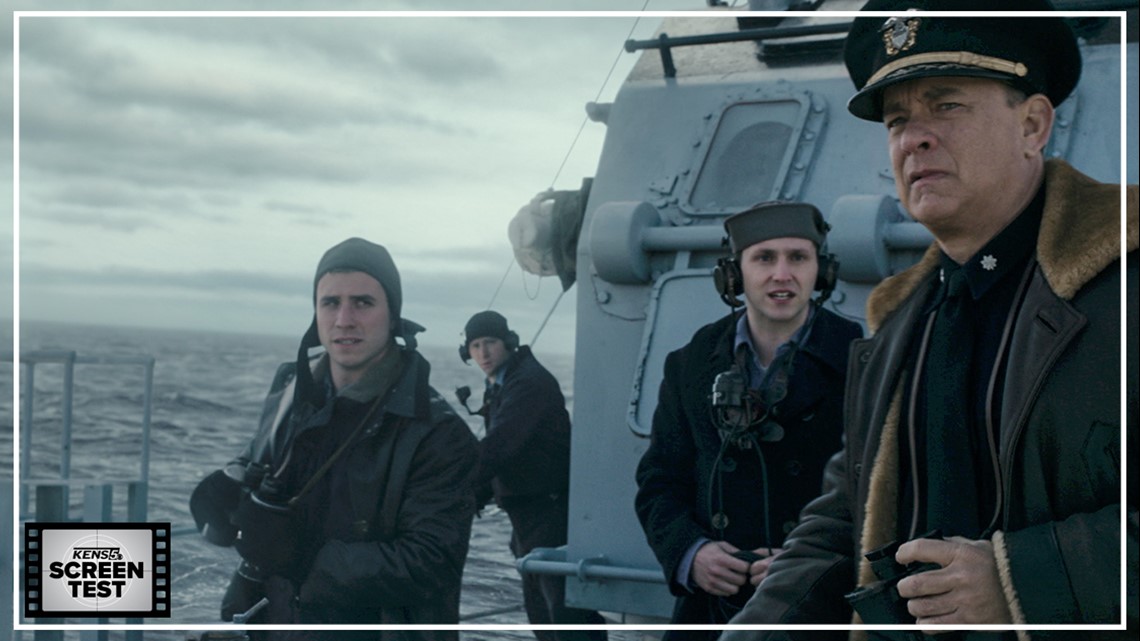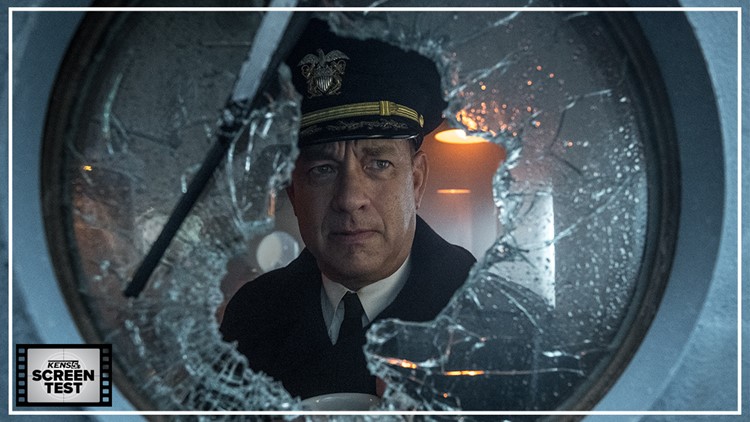What does a Tom Hanks performance represent in 2020, as one of America’s most enduring actors – whose consistency on the screen is matched only by his squeaky-clean celebrity – enters a fifth decade of feature film work? Or maybe the question should be: What more can a Tom Hanks performance represent, especially in the wake of a half-decade where Hollywood has both found his perfect archetype while also somewhat pigeon-holing Hanks into the role of non-partisan American hero (See: “Sully,” “The Post,” “A Beautiful Day in the Neighborhood”).
“Greyhound,” which premieres on Apple TV+ Friday, doesn’t really provide an answer. But it does wholly encapsulate the question, to a degree that makes one wonder what Hanks himself thinks of his role in the history of American cinema, and perhaps in the history of American storytelling at large. The movie – a World War II maritime drama that soaks in tempered spectacle and little else – isn’t particularly great (it isn’t horrible either!), with issues stemming from its noncommittal tone. Is this a character study first and tense war thriller second, or vice-versa? That may not be worth contemplating of a movie that feels like it was once an outline for “Call of Duty: Maritime,” with a rote mission structure, faceless/nameless baddies and a general lack of consequence.
Then again, the mere involvement of Tom Hanks – the inimitable Tom Hanks – is enough to complicate the entire equation.
Directed by Aaron Schneider, who won a Best Live Action Short Oscar back when Hanks had still done just two “Toy Story” flicks, “Greyhound” begins by tuning us into the era via radio news reports and transmissions. It’s 1942, and ships carrying crucial supplies to the Allied forces are about to cross the “Black Pit”—so named because overhead air support is unable to accompany them for the next few days.
Schneider’s extensive background manning the camera on TV projects ensures he has the stuff to make the rocky waters of the Atlantic look darkly treacherous, but even more ominous is the threat of Nazi U-boats waiting to torpedo the ships into submission. “Godspeed,” a friendly pilot communicates to Greyhound – the ship leading the convoy – in a message the movie strangely translates via on-screen text, as if they forgot to record the dialogue.
At the helm of Greyhound is Hanks’s Captain Krause, kneeling by his bed and wrapping up a prayer that he’ll live to see land once again. He’s a respected figure, if not for a reputation then for the responsibility he holds for the lives of his crewmen and the several ships following in tow. And even as the movie’s intentions of fleshing out character backstories and unique motivations are practically nonexistent, our decades-long relationship with Hanks is enough to empathize with wanting to follow his every command, meet his every courtesy. In one funny moment, a crewman casually blurts out “f**k” in front of Krause, before immediately apologizing. Why of course—you don’t curse in front of Tom Hanks! And you sure as hell don’t try to sink him (COVID-19 gave its best shot earlier this spring).
Naturally, lurking enemy submarines will try to anyway, for the next four days in the movie and the next 90 minutes on our small screens. A cat-and-mouse game unfolds between the Greyhound and one formidable German U-boat in particular, although what transpires is a domination of aesthetic over an engaging story, making “Greyhound” veer much closer to being “Battleship: The Movie,” even as the movie expends too much effort resisting the urge not to be.
Even with the brief runtime, things begin feeling repetitive once we realize “Greyhound” has shown its hand in a blistering early sequence of high-seas chess between Greyhound and the first sub it encounters. Powered by sonar screams, a strong score from Blake Neely shoulders much of the burden in translating a sense of immediacy, but “Greyhound” also ably instills a sense of yestercentury warfare with constant, nervous chatter of contact bearings and sonar ranges and “steady as we go”—if the movie isn’t totally period-accurate, there’s room to appreciate this early cat-and-mouse match as a show of process more than anything.
The problem is that there’s very little “Greyhound” offers its audience beyond tense moments of high-stakes hide-and-seek. By the time the radio chips with “Target sighted!” for the dozenth time, it all begins to feel a bit numb as an exercise in holding firm under the most intense pressure. Hanks, meanwhile, remains a reliable bastion of determination and defiance in the face of what Krause faces, but we’ve seen more charismatic turns in individual scenes from the actor.


And yet, it’s clear Hanks has an investment in the project. “Greyhound,” interestingly enough, is one of just three feature screenplay Hanks himself has ever penned, and the first since 2011’s “Larry Crowne.” In adapting C. S. Forester’s novel “The Good Shepherd,” he prioritizes a narrative seemingly hyper-focused but also insistent on carving out emotional stakes for the titular Navy ship’s captain. That the film flirts with a bizarrely ill-fitting romantic subplot – an awkward attempt to make Krause more than just an insomniac order-barker and barometer of grace under pressure – only sharpens the suspicion that “Greyhound” isn’t sure what its most worthwhile version is. And while things don’t stoop to Michael Bay-levels of fetishistic destruction, there’s no believing the screenplay’s attempts at interrogating the casualties of this convoy’s voyage. War’s horrors – more effectively portrayed in “Dunkirk,” “Hacksaw Ridge” and “1917” – are limited to ships burning in the distance, and the remains of enemy U-boats that look like mere oil spills.
And yet there’s something to the way Hanks is utilized that might explain why the movie feels so one-note. If “Greyhound” functions as tribute to forgotten heroes of the world’s bloodiest conflict, it’s at least just as much a vehicle for Hanks to indulge his passions—especially given how the movie’s narrow roads of exploration into wartime loss tend to lead right back to our captain’s furrowed brow and grave stares. Other war movies have explored those effects with other actors, to be sure. But other actors aren’t Tom Hanks. And “Greyhound” is fully aware of the traits shared by both actor and character; how they’re both formidable, successful, fully worthy of a hat tip.
I’m hard-pressed, then, to consider the movie as more than hero worship for Hanks himself; the movie is a comment on Hanks’s celebrity just as much as “The Way Back” is for Ben Affleck’s. Does that mean the mere symbolism of Hanks – the candor, the frankness, the seeming invincibility – is too grand to fit into a technically grand movie about one of history’s grandest events? I’m not sure if I’m willing to go that far. But it’s worth wondering why, in “Greyhound’s” emotional climax of literal applause, it’s far too easy to see not Captain Krause walking the deck of the titular ship, but Tom Hanks himself.
"Greyhound" is rated PG-13 for war-related action/violence and brief strong language. It begins streaming on Apple TV+ Friday.
Starring: Tom Hanks, Stephen Graham, Elisabeth Shue, Michael Benz
Directed by Aaron Schneider
2020
OTHER SCREEN TEST REVIEWS
- ‘Palm Springs’ Review: Andy Samberg and Cristin Milioti star in 2020’s most unexpected pandemic-era allegory
- ‘Desperados’ Review: Netflix’s latest will take you through the seven circles of cliché hell
- 'The Truth' Review: Catherine Deneuve shines in Hirokazu Kore-eda's drama about family, memory and narrative
- ‘Eurovision Song Contest’ Review: Overlong Will Ferrell-Rachel McAdams comedy is enjoyable when it leans into the outrageous
- The best movies from the first half of 2020
- ‘My Spy’ Review: Dave Bautista’s talents are wasted in uninspired genre mashup
- ‘House of Hummingbird’ Review: Tender South Korean drama finds empathy in harrowing moments of teenagerdom
- 'Shirley' Review: Elisabeth Moss powers bewitching psychological drama about an author and her muse



